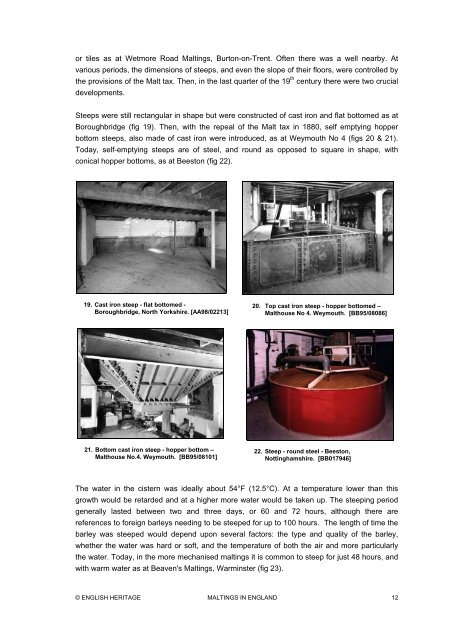Maltings in England - English Heritage
Maltings in England - English Heritage
Maltings in England - English Heritage
You also want an ePaper? Increase the reach of your titles
YUMPU automatically turns print PDFs into web optimized ePapers that Google loves.
or tiles as at Wetmore Road <strong>Malt<strong>in</strong>gs</strong>, Burton-on-Trent. Often there was a well nearby. At<br />
various periods, the dimensions of steeps, and even the slope of their floors, were controlled by<br />
the provisions of the Malt tax. Then, <strong>in</strong> the last quarter of the 19 th century there were two crucial<br />
developments.<br />
Steeps were still rectangular <strong>in</strong> shape but were constructed of cast iron and flat bottomed as at<br />
Boroughbridge (fig 19). Then, with the repeal of the Malt tax <strong>in</strong> 1880, self empty<strong>in</strong>g hopper<br />
bottom steeps, also made of cast iron were <strong>in</strong>troduced, as at Weymouth No 4 (figs 20 & 21).<br />
Today, self-empty<strong>in</strong>g steeps are of steel, and round as opposed to square <strong>in</strong> shape, with<br />
conical hopper bottoms, as at Beeston (fig 22).<br />
19. Cast iron steep - flat bottomed -<br />
Boroughbridge, North Yorkshire. [AA98/02213]<br />
20. Top cast iron steep - hopper bottomed –<br />
Malthouse No 4. Weymouth. [BB95/08086]<br />
21. Bottom cast iron steep - hopper bottom –<br />
Malthouse No.4. Weymouth. [BB95/08101]<br />
22. Steep - round steel - Beeston,<br />
Nott<strong>in</strong>ghamshire. [BB017946]<br />
The water <strong>in</strong> the cistern was ideally about 54°F (12.5°C). At a temperature lower than this<br />
growth would be retarded and at a higher more water would be taken up. The steep<strong>in</strong>g period<br />
generally lasted between two and three days, or 60 and 72 hours, although there are<br />
references to foreign barleys need<strong>in</strong>g to be steeped for up to 100 hours. The length of time the<br />
barley was steeped would depend upon several factors: the type and quality of the barley,<br />
whether the water was hard or soft, and the temperature of both the air and more particularly<br />
the water. Today, <strong>in</strong> the more mechanised malt<strong>in</strong>gs it is common to steep for just 48 hours, and<br />
with warm water as at Beaven's <strong>Malt<strong>in</strong>gs</strong>, Warm<strong>in</strong>ster (fig 23).<br />
© ENGLISH HERITAGE MALTINGS IN ENGLAND 12
















